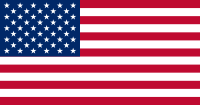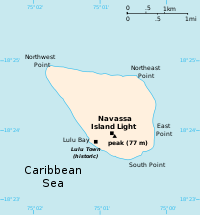Navassa Island
 |
|
 |
|
| Owned by | United States |
|---|---|
| Claimed under | Guano Islands Act |
| Island Type | Coral, limestone |
| Discovered | 1504 |
| Claimed for United States |
October 1857 |
| Discovered by | Christopher Columbus |
| Area | 2 sq mi (5.2 km2) |
| Population | Uninhabited. Hundreds of laborers lived here while it was being mined |
| Transportation | Offshore anchorage only; steep cliffs make boat landing impossible |
| Major Settlements | Lulu Town |
| Uses | Mined for guano between 1865-1898; now a wildlife preserve |
| Additional Claims | Haiti |
| FIPS territory code | bq |
Navassa Island (French: La Navase, Haitian Kreyòl: Lanavaz or Lavash) is a small, uninhabited island in the Caribbean Sea, and is an unorganized unincorporated territory of the United States, which administers it through the U.S. Fish and Wildlife Service. The island is also claimed by the Republic of Haiti, which claims to have had sovereignty over Navassa since 1801.[1]
Contents |
Geography and Topography
Navassa Island is about two square miles (5.2 km²). It is found at a strategic location 90 nautical miles (100 mi/170 km) south of the U.S. naval base at Guantanamo Bay, Cuba, about one-quarter of the way from Haiti to Jamaica in the Jamaica Channel. It reaches an elevation of 250 feet (76 m) at Dunning Hill 110 yards (100 m) south of the lighthouse, Navassa Island Light. This location is 440 yards (400 m) from the southwestern coast or 655 yards (600 m) east of Lulu Bay. The island's latitude and longitude is .


The terrain of Navassa Island consists mostly of exposed coral and limestone, the island being ringed by vertical white cliffs 30 to 50 feet (9 to 15 m) high, but with enough grassland to support goat herds. The island is covered in a forest of just four tree species: short-leaf fig (Ficus populnea var. brevifolia), pigeon plum (Coccoloba diversifolia), mastic (Sideroxylon foetidissimum) and poisonwood (Metopium brownei)[2][3]. Its topography and ecology is similar to that of Mona Island, a small limestone island located in the Mona Passage, between Puerto Rico and the Dominican Republic. It shares the same historical similarities as Mona Island since both are U.S. territories, were once centers of guano mining, and presently are nature reserves. Transient Haitian fishermen and others camp on the island but the island is otherwise uninhabited. It has no ports or harbors, only offshore anchorages, and its only natural resource is guano; economic activity consists of subsistence fishing and commercial trawling activities.
History
In 1504, Christopher Columbus, stranded on Jamaica, sent some crew members by canoe to Hispaniola for help. They ran into the island on the way, but it had no water. They called it Navaza (from "nava-" meaning plain, or field), and it was avoided by mariners for the next 350 years.
Despite an earlier claim by Haiti, Navassa Island was claimed for the United States in 1857 by Peter Duncan, an American sea captain, the third island to be claimed under the Guano Islands Act of 1856, because of the island's guano deposits. These deposits were actively mined from 1865 to 1898. Haiti protested the annexation, but the U.S. rejected the Haitian claim and since October 1857 has claimed the island as an unincorporated territory (according to the Insular Cases.)

Guano phosphate was a superior organic fertilizer that became a mainstay of American agriculture in the mid-19th century. Duncan transferred his discoverer's rights to his employer, an American guano trader in Jamaica, who sold them to the newly-formed Navassa Phosphate Company of Baltimore. After an interruption for the U.S. Civil War, the Company built larger mining facilities on Navassa with barrack housing for 140 black contract laborers from Maryland, houses for white supervisors, a blacksmith shop, warehouses, and a church. Mining began in 1865. The workers dug out the guano by dynamite and pick-axe and hauled it in rail cars to the landing point at Lulu Bay, where it was sacked and lowered onto boats for transfer to the Company barque, the S.S. Romance. The living quarters at Lulu Bay were called Lulu Town, as appears on old maps. Railway tracks eventually extended inland.
Hauling guano by muscle-power in the fierce tropical heat, combined with general disgruntlement with conditions on the island eventually provoked a rebellion in 1889, in which five supervisors died. A U.S. warship returned eighteen of the workers to Baltimore for three separate trials on murder charges. A black fraternal society, the Order of Galilean Fisherman, raised money to defend the miners in federal court, and the defense built its case on the contention that the men acted in self-defense or in the heat of passion, and that the United States did not have jurisdiction over the island. The cases, including Jones v. United States, went to the U.S. Supreme Court in October 1890, which ruled the Guano Act constitutional, and three of the miners were scheduled for execution in the spring of 1891. A grass-roots petition drive by black churches around the country, also signed by white jurors from the three trials, reached President Benjamin Harrison, who commuted the sentences to imprisonment.
Guano mining resumed on Navassa at a much reduced level. The Spanish-American War of 1898 forced the Phosphate Company to evacuate the island and file for bankruptcy, and the new owners abandoned the island after 1901.


Navassa became significant again with the opening of the Panama Canal in 1914. Shipping between the American eastern seaboard and the Canal goes through the Windward Passage between Cuba and Haiti. Navassa, a hazard to navigation, needed a lighthouse. The U.S. Lighthouse Service built Navassa Island Light, a 162 foot (46 m) tower on the island in 1917, 395 feet (120 m) above sea level. A keeper and two assistants were assigned to live there until the United States Lighthouse Service installed an automatic beacon in 1929. After absorbing the Lighthouse Service in 1939, the U.S. Coast Guard serviced the light twice each year. The U.S. Navy set up an observation post for the duration of World War II. The island has been uninhabited since then.
A scientific expedition from Harvard University studied the land and marine life of the island in 1930. Since World War II, amateur radio operators have landed frequently to operate from the territory, which is accorded "country" status by the American Radio Relay League. Fishermen, mainly from Haiti, fish the waters around Navassa.

From 1903 to 1917, Navassa was a dependency of the U.S. Guantanamo Bay Naval Base, and from 1917 to 1996 it was under United States Coast Guard administration. Since 16 January 1996, it has been administered by U.S. Department of the Interior. On August 29, 1996, the United States Coast Guard dismantled the light on Navassa. An inter-agency task force headed by the U.S. Department of State transferred oversight of the island to the U.S. Department of the Interior. By Secretary's Order No. 3205 of January 16, 1997, the Interior Department assumed control of the island and placed the island under its Office of Insular Affairs. For statistical purposes, Navassa was grouped with the now-obsolete term United States Miscellaneous Caribbean Islands and is now grouped with other islands claimed by the U.S. under the Guano Islands Act islands as the United States Minor Outlying Islands.
A 1998 scientific expedition led by the Center for Marine Conservation in Washington D.C. described Navassa as "a unique preserve of Caribbean biodiversity." The island's land and offshore ecosystems have survived the twentieth century virtually untouched. The island will be studied by annual scientific expeditions for the next decade at least.
By Secretary's Order No. 3210 of December 3, 1999, the U.S. Fish and Wildlife Service assumed administrative responsibility for Navassa, which became a National Wildlife Refuge Overlay, also known as Navassa Island National Wildlife Refuge. The Office of Insular Affairs retains authority for the island's political affairs and judicial authority is exercised directly by the nearest U.S. Circuit Court. Access to Navassa is hazardous and visitors need permission from the Fish and Wildlife Office in Boqueron, Puerto Rico in order to enter its territorial waters or land. Since this change of status, amateur radio operators have repeatedly been denied entry.
Fictional State
A group of Colombians, invoking the principle of international law of Uti possidetis iuris founded the Sovereign State of Navassa on October 12, 2005.
|
||||||||||||||
|
||||||||||||||
See also
- Political divisions of the United States
- List of islands of Haiti
- Insular areas
- Flag of Navassa Island
References and External links
- ↑ Serge Bellegarde (October 1998). "Navassa Island: Haiti and the U.S. – A Matter of History and Geography". windowsonhaiti.com. Retrieved on 2008-02-06.
- ↑ Navassa National Wildlife Refuge Wildlife
- ↑ Navassa Island:Terrestrial biota
- STATE OF NAVAZA
- Navassa Island profile - OIA
- A photographic tour of Navassa Island - USGS
- Navassa Island World Factbook entry - CIA
- The King of Navassa Island
- Navassa Island Coral Reefs
- U.S Fish & Wildlife Service: Navassa National Wildlife Refuge
- The Navassa island riot. Illustrated. Published by the National Grand Tabernacle, Order of Galillean Fishermen, Baltimore, Md.
US-Haiti Territorial Dispute
Fabio Spadi (2001). "Navassa: Legal Nightmares in a Biological Heaven". IBRU Boundary & Security Bulletin.
|
|||||||||||||||||||||||||||||||||||||
|
|||||||||||||||||||||||||
|
||||||||||||||
